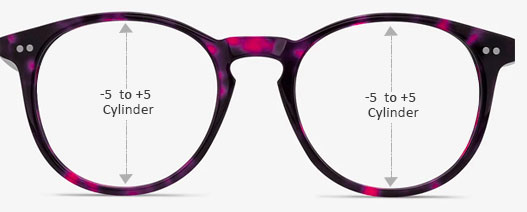
PRESCRIPTION GUIDE PAGE
When it’s time to buy eyeglasses, you’ll need to know all this information. (Note that this is not the same as a prescription for contact lenses.) First, however, what do all of these acronyms and numeric codes mean?
We’ll walk you through the steps of your prescription. By the conclusion of this post, you’ll know exactly how to interpret your glasses prescription and what it signifies.

To What Extent Are OD and OS Defined?
You’ll discover the abbreviations OD and OS on the left side of your prescription. For example, Oculus Dexter and Oculus Sinister are Latin acronyms for the Latin phrases oculus.
OS stands for the Left Eye, whereas OD stands for the Right Eye.
You may also have an OU column, which signifies Oculus Uterque, or both eyes.
Some eye doctors have updated this by replacing OD with RE (Right Eye) and OS with LE (Left Eye) .
What does SPH stand for?
Nearsightedness and farsightedness can be corrected by the amount of lens power indicated by the sphere, or SPH.
A person who is nearsighted can clearly see close objects, but faraway items are obscured.
A farsighted person sees far objects clearly, whereas nearby objects appear blurry.
The lens’s refractive power (light-bending) is measured in diopters, which is a unit of measurement.
It signifies that it is Correcting nearsightedness if the number is negative (-). Also it is Correcting long-sightedness if the number is positive (+)
Distance vision correction is referred to as “sphere” because it is spherical, or equal, along all of the eye’s meridians.

CYL stands for what?
Following the sphere power in your eyeglass prescription is the CYL cylinder, abbreviated CYL. The number of diopters represents the amount of lens power required to correct astigmatism.
There is no astigmatism if this column is empty. Nearsighted astigmatism can be corrected using a number that has a negative sign (–) in front of it. Astigmatism is corrected if the number bears a plus sign (+) or is positive (+).
The correction of astigmatism is not spherical. This means that one meridian has no extra power, whereas the meridian perpendicular to it has the highest lens curvature and power.
What Is the Meaning of Axis?
When it comes to astigmatism correction, the lens meridian with no cylindrical power is the axis. Using a number from 1 to 180, the axis is labeled.
An axis is required if cylinder power is included in a prescription. The axis value is commonly preceded by a “x” when writing in freehand.
At each given point in time, the astigmatism-correcting lens power is precisely 90 degrees from the axis.
Does Add Have Any Meaning?
Add means Addition in Power. Bifocal, multifocal, or progressive lenses that correct presbyopia by adding magnification to the lower portion of the lens are called “add” (age-related farsightedness).
As long as there is no plus sign (+) in front of this number, it’s always positive. Between +0.75 and +3.00, these readings are frequently the same for both eyes.
Additional Information Regarding Your Eye Prescription
Your optometrist or ophthalmologist may have filled in extra information about your eyes’ health.
Multifocals, progressives, anti-reflective coating, photochromic or transition lenses are some of the more common recommendations for corrective eyewear.
Prescriptions for eyeglasses may need taking a PD measurement.
What does PD stand for?
The distance in millimeters between the center of each pupil and the bridge of your nose is known as the “pupillary distance,” “pupil distance,” or “simply PD.” When designing prescription glasses, the distance between your eyes is crucial because it tells us where to set the focal point of your vision. Without an accurate measurement, even if your prescription is 100 percent correct, your lenses will have an incorrect prescription power and you would be unable to see out of your spectacles.
Optometrists have measured and crafted your lenses using your PD, even if you weren’t aware of it. There are times when an eye exam’s printout prescription doesn’t include this measurement. Online eyeglasses ordering requires either a PD measurement or a visit to the eye doctor to obtain one.
Is it okay if I just take a wild guess at my PD?
Prescription eyeglasses should not be ordered based on a hunch about your pupillary distance.
For prescription glasses to function effectively, the distance between the eyes must be precisely measured. If you get a pair of shoes that are either too big or too tiny, you’ll need to measure your feet and order a new pair. Prescription glasses will not work properly if you don’t order the correct pupillary distance, and you will have to get a new pair. This is the same premise.


